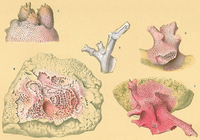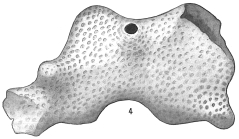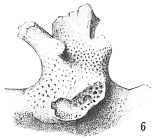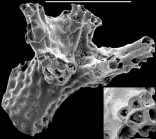WoRMS taxon details
Miniacina Galloway, 1933
112211 (urn:lsid:marinespecies.org:taxname:112211)
accepted
Genus
Millepora miniacea Pallas, 1766 accepted as Miniacina miniacea (Pallas, 1766) (type by original designation)
Pustularia Gray, 1858 · unaccepted (Subjective junior synonym Opinion...)
Subjective junior synonym Opinion of Loeblich & Tappan, 1987 Homonym of Pustularia Swainson (1840)
marine, brackish, fresh, terrestrial
Galloway, J. J. (1933). A manual of Foraminifera. <em>Bloomington, Principia Press.</em> , available online at https://babel.hathitrust.org/cgi/pt?id=uc1.31822014134829 [details]
Hayward, B.W.; Le Coze, F.; Vachard, D.; Gross, O. (2024). World Foraminifera Database. Miniacina Galloway, 1933. Accessed through: World Register of Marine Species at: https://www.marinespecies.org/aphia.php?p=taxdetails&id=112211 on 2024-04-19
Date
action
by
2006-09-25 06:54:45Z
changed
Martinez, Olga
![]() The webpage text is licensed under a Creative Commons Attribution 4.0 License
The webpage text is licensed under a Creative Commons Attribution 4.0 License
original description
Galloway, J. J. (1933). A manual of Foraminifera. <em>Bloomington, Principia Press.</em> , available online at https://babel.hathitrust.org/cgi/pt?id=uc1.31822014134829 [details]
original description (of Pustularia Gray, 1858) Gray, J. (1858). On Carpenteria and Dujardinia, two genera of a new form of Protozoa with attached multilocular shells filled with sponge, apparently intermediate between Rhizopoda and Porifera. <em>Proceedings of the Zoological Society of London.</em> 26(1): 266-271., available online at https://www.biodiversitylibrary.org/part/74104#/summary
page(s): p. 270-271 [details]
basis of record Gross, O. (2001). Foraminifera, <B><I>in</I></B>: Costello, M.J. <i>et al.</i> (Ed.) (2001). <i>European register of marine species: a check-list of the marine species in Europe and a bibliography of guides to their identification. Collection Patrimoines Naturels,</i> 50: pp. 60-75 (look up in IMIS) [details]
additional source Neave, Sheffield Airey. (1939-1996). Nomenclator Zoologicus vol. 1-10 Online. <em>[Online Nomenclator Zoologicus at Checklistbank. Ubio link has gone].</em> , available online at https://www.checklistbank.org/dataset/126539/about [details]
additional source Loeblich, A. R.; Tappan, H. (1987). Foraminiferal Genera and their Classification. Van Nostrand Reinhold Company, New York. 970pp., available online at https://books.google.pt/books?id=n_BqCQAAQBAJ [details] Available for editors [request]
[request]
original description (of Pustularia Gray, 1858) Gray, J. (1858). On Carpenteria and Dujardinia, two genera of a new form of Protozoa with attached multilocular shells filled with sponge, apparently intermediate between Rhizopoda and Porifera. <em>Proceedings of the Zoological Society of London.</em> 26(1): 266-271., available online at https://www.biodiversitylibrary.org/part/74104#/summary
page(s): p. 270-271 [details]
basis of record Gross, O. (2001). Foraminifera, <B><I>in</I></B>: Costello, M.J. <i>et al.</i> (Ed.) (2001). <i>European register of marine species: a check-list of the marine species in Europe and a bibliography of guides to their identification. Collection Patrimoines Naturels,</i> 50: pp. 60-75 (look up in IMIS) [details]
additional source Neave, Sheffield Airey. (1939-1996). Nomenclator Zoologicus vol. 1-10 Online. <em>[Online Nomenclator Zoologicus at Checklistbank. Ubio link has gone].</em> , available online at https://www.checklistbank.org/dataset/126539/about [details]
additional source Loeblich, A. R.; Tappan, H. (1987). Foraminiferal Genera and their Classification. Van Nostrand Reinhold Company, New York. 970pp., available online at https://books.google.pt/books?id=n_BqCQAAQBAJ [details] Available for editors
 Present
Present  Inaccurate
Inaccurate  Introduced: alien
Introduced: alien  Containing type locality
Containing type locality
From editor or global species database
Diagnosis Megalospheric generation with raspberrylike cluster of globular chambers, consisting of proloculus, gradually enlarging second globular chamber, and third larger, ovoid chamber forming a free-living early stage, numerous stolons radiating from the third chamber connect to the surrounding tubular to reniform chambers, microspheric generation with five to nine chambers in an early trochospire of about one and a half whorls; following the juvenile three-chambered or trochospiral stage, the test attaches to a substrate, commonly to other shells, the attached base varying from narrow to spreading, and up to 5 mm in diameter, from this base arise vertical conical to irregularly branching structures up to 7 mm in height, the central core of the branches formed by irregular and bifurcating but nonseptate imperforate and double-walled cylindrical vertical tubes that expand at the open ends, the core surrounded by encrusting compartments termed pillar-pore chambers with tubelike infoldings of the wall at the base, normal chambers occur between the pillarpore chambers and may utilize their walls, successive chambers overlap both the earlier true chambers and pillar-pore chambers; wall of proloculus thick and proteinaceous, succeeding chambers with thick organic layer that is progressively thinner in later chambers, and an outer calcareous layer that may have numerous irregular channels against the organic layer, finally with calcareous layers on both sides of the very thin organic layer, wall light pink to red in color, rarely white, hyaline, of optically radial calcite, small pores of 3 µm to 4 µm in diameter, and larger interspersed pillar-pores up to 50 µm in diameter that open into the pillar-pore chambers and result in a pock-marked surface, wall of pillar-pore tubes imperforate, lamellae may obscure the pores of earlier parts of the wall as new layers of chambers are added; chambers of early stage with one or more apertures at the peripheral margin, adult with one to multiple rounded apertures with phialine bordering lip at the ends of the branches, chambers near the multiple apertures may be subdivided into tubular chamberlets or apertural tubes by intertubular partitions, chambers and pillar-pore chambers interconnected only by the fine wall perforations and not by foramina, large openings at the ends of the branches not involved in later chamber formation. L. Miocene (Aquitanian) to Holocene; cosmopolitan in warm waters. (Loeblich & Tappan, 1987, Foraminiferal Genera and Their Classification) [details]
To European Nucleotide Archive (ENA) (from synonym Pustularia Gray, 1858)
To European Nucleotide Archive (ENA) (from synonym Pustularia Gray, 1858)
To ITIS
To European Nucleotide Archive (ENA) (from synonym Pustularia Gray, 1858)
To ITIS




